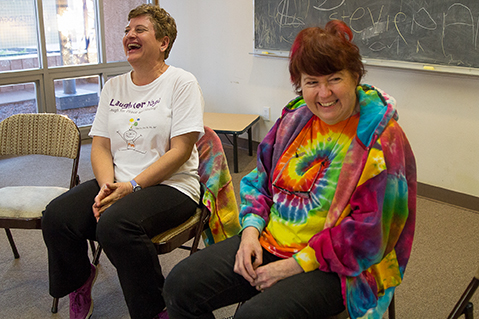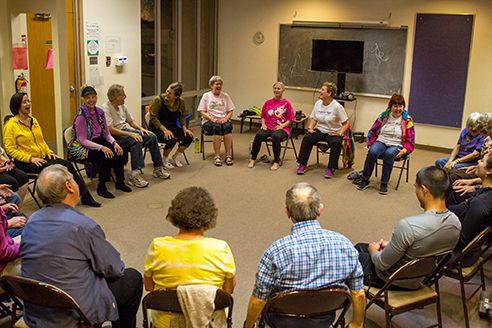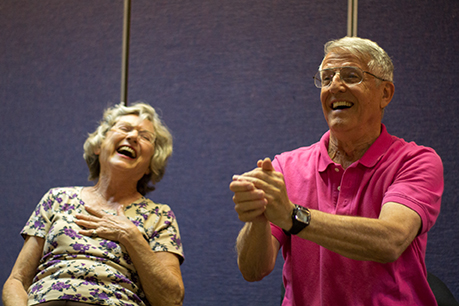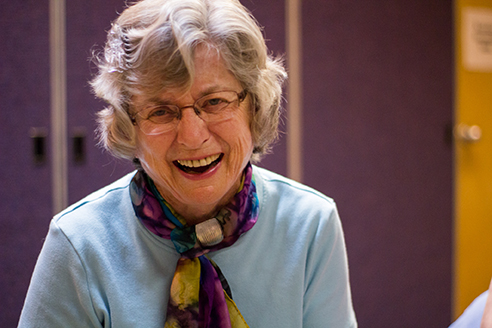
Sometimes laughter is the best medicine. Along with a little yoga.
Laughter yoga, which incorporates breathing and laughter exercises to stimulate relaxation, is creating more smiles across Arizona as health practitioners realize the benefits of mirth in life.
Fourteen “Laughter Clubs” are recognized in Arizona by LaughterYoga.Org, the official website for the “health and fitness craze that is sweeping the world.” In the past year, Arizona laughter yoga leaders have seen a rise in interest due to social media and word of mouth.
“We say fake it till you make it in here,” said Jana Martin, leader of Tucson Tuesday Laughter Yoga. “Your body doesn’t know the difference between fake laughter and genuine laughter. You can still reap all the benefits through fake laughter, but the two eventually morph together.”
Founded by an Indian doctor 20 years ago, laughter yoga follows four basic steps: breathing and stretching, clapping and chanting, laughter exercises, and meditation.
Martin and co-leader Loti Gest have never missed a single Tuesday session at St. Francis in the Foothills in Tucson since May 2010. The free club attracts about 10-25 middle-aged individuals from the community every week, according to Martin.
“It’s great for people who have mobility issues because not everyone can participate in a traditional way,” Martin said. “It’s really great for certain populations who really can’t move very much.”
At Tucson Tuesday Laughter Yoga sessions, participants do not bring yoga mats and tights but wear jeans and bring laughing towels.
During exercises, eye contact contributes to contagious laughter and helps people laugh harder to gain more benefits, said Martin. Laughter exercises done at Martin’s session includes greeting one another by bowing down Namaste style and laughing, throwing an imaginary ball around a circle for five minutes and singing Happy Birthday in gibberish.
After the laughter exercises are done, members spread around the room as Martin guides the group through visual meditation to recover from the workout.
Martin said laughter yoga can be awkward at first, but with the help of eye contact and contagious laughter, the nervousness is short lived. She said laughter yoga helps her breathe deeper, sleep better and improve her digestive system while forming a sense of community with her peers.
The science behind laughter
Doctor Gulshan Sethi, a laughter yoga instructor and practitioner in Tucson, is currently the head of cardiothoracic surgery at Tucson Medical Center. Sethi has been a heart surgeon for 40 years and has about 15,000 heart surgeries under his scrubs. When he is out of the operating room, Dr. Sethi continues saving lives by making people laugh their way to good health.
“Laughter is universal,” Sethi said. “It transcends all barriers and it knows no age, color or race.”
He prescribes a daily laughing routine, for about 30 minutes, to receive long lasting psychological and physiological benefits.
After being diagnosed with spinal stenosis, narrowing of the spine, and enduring extreme pain on a daily basis, Sethi searched for a cure. Faced with a choice between daily medications or a massive operation, he declined both and formulated his own remedy: laughter.
After researching and talking to his colleagues, Sethi said he kept stumbling upon laughter as a form of therapy. Sethi said he always knew laughter was a positive thing, but was still skeptical about its serious long lasting health benefits.
“Being a scientist, I had to know what it was all about. You tell me something, and I don’t believe it. I needed to learn myself and investigate to prove how laughter helps us scientifically,” Sethi said.
Sethi produced a pilot study, along with his colleagues from the University of Arizona, to identify health benefits generated by laughter yoga. The study observed six patients at the UA Health and Sciences awaiting organ transplants over weeks and 10 laughter yoga sessions.
According to the study’s results, “Participants showed improved immediate mood and increased heart rate variability after the laughter intervention… appeared to improve longer-term anxiety.” The findings encouraged Sethi to try laughter therapy himself.
Sethi said laughter yoga can also help prevent common colds as well as cure diseases. The slow deep breathing in laughter yoga improves heart rate variability, “the projector of longevity as well as how you feel every day.” When laughing, air is expired and gets rid of residual air in the lungs. This decreases the moisture in the bronchial tree, and people are less likely to develop infections.
Sethi also said laughing releases endorphins, which affects a person’s overall well being while decreasing stress hormones and physical pain.
Stu Goldman, a patient of Sethi, attended his February Laughter Yoga session at The Core in La Encantada Mall in Tucson. A year ago, Sethi did a micro valve replacement and a double bypass surgery on Goldman. “And I’m still here,” Goldman said.
His first time participating in laughter yoga was memorable, he said. Seeing Dr. Sethi in a different environment encourages Goldman to attend and reap the benefits from laughter yoga.
“It was great. I was feeling blue before I got here but I’m better. I already signed up for Dr. Sethi’s March session,” Goldman said.
Laughter yoga also increases the number and the activity of natural killer cells, the cells which kill cancer, Sethi said. Another study out of Iran found that laughter yoga can lower stress in cancer sufferers before chemotherapy through the release of endorphins.
Emotional benefits
In Tempe, Linda Scharf has been a laughter yoga leader at the Southwest Institute of Healing Arts since it began in 2009. Over the past eight years, Scharf has seen participants ranging from 2-month-old babies to over 80-year-old seniors.
“Laughter yoga does not require the physical ability that conventional yoga does and can be done by anyone, anywhere,” Scharf said.
Scharf said she has witnessed many people gain emotional benefits from laughter yoga after traumatic events.
“People have come to laughter club meetings after losing a spouse or a child or while going through a difficult divorce, a serious illness, or other traumatic circumstances. Laughter yoga gives them a way to laugh when they don’t have a reason to do so and it can change their life,” Scharf said.
She said she achieves this by including laughter exercises that are geared towards stress relief, something participants at SWIHA can benefit from in their daily life.
The Rev. Em Maxwell, leader of the Green Valley Laughter Club, said she focuses on the spiritual benefits from laughter yoga.
“Having a daily laughter practice is spiritual because it helps you not only look for the good in everything, but perceive and contribute to the good in everything,” Maxwell said. “Knowledge is wonderful, beautiful and helpful but it’s not knowledge that creates a good life. It’s attitude that creates a good life.”
Laughter Yoga from Noelle Haro-Gomez on Vimeo.
Juliana Romeo is a reporter for Arizona Sonora News, a service from the School of Journalism with the University of Arizona. Contact her at jromeo@email.arizona.edu.
Click here for a Word version of this story and high-resolution photos





do you teach classes to become a laughter yoga instructor
Thank you
Debra